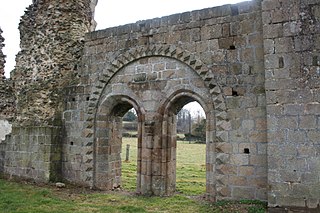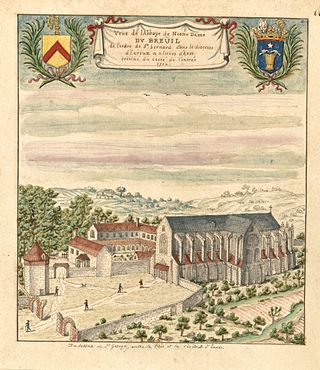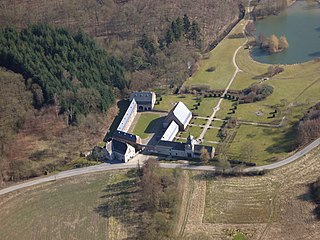
Reigny Abbey (Abbaye de Reigny) was a Cistercian monastery in Vermenton, department of Yonne, Bourgogne, France.

Reigny Abbey (Abbaye de Reigny) was a Cistercian monastery in Vermenton, department of Yonne, Bourgogne, France.

The abbey was founded in 1104 at Fontemoy as a hermitage, or small priory, by the knight Anseric of Avallon and Gui of Noyers. it grew quickly and in 1128 was accepted into the Cistercian Order as a daughter house of Clairvaux Abbey. The first abbot was Stephen of Toucy, a monk of Clairvaux. In 1134 the monastery was moved to the present site on the right bank of the river Cure, a gift to the community from William II, Count of Auxerre and Nevers. In 1147 it was granted papal protection by Pope Eugene II.
The abbey continued to thrive and at its peak numbered up to 300 monks. The generosity of the local nobility provided it with sufficient estates to maintain this large population and engage in active trade with its surplus produce. In 1370 King Charles V of France granted it royal protection, and in 1493 Charles VIII made it a fondation royale. It suffered severely however both during the Hundred Years' War and in the French Wars of Religion. In 1582 [1] the Huguenots destroyed most of it by fire, including the church.

The monastic buildings were rebuilt during the 17th-18th centuries. The new church was completed in 1759–1765; the work is often attributed to Claude-Nicolas Ledoux but according to the French Ministry of Culture and Communication is by the less well-known royal architect Claude-Louis d'Aviler. [2]
The abbey was dissolved in 1790 during the French Revolution; the community at that point comprised eight monks. Many of the buildings, among them the new church, the cloisters, the chapter house and the greater part of the conventual buildings, were destroyed. Many decorative items from the former abbey church are still to be found in churches nearby.
The precinct and surviving buildings, principally comprising the exceptional 14th century refectory, the 17th century dovecote and part of the south range of the conventual buildings restored in the 18th century, including the monks' parlour and dormitory, passed into private ownership. The site is now commercially run as a conference and event centre.
The abbey site was classed as a monument historique in 1920. [3]

Clairvaux Abbey was a Cistercian monastery in Ville-sous-la-Ferté, 15 kilometres (9.3 mi) from Bar-sur-Aube. The original building, founded in 1115 by Bernard of Clairvaux, is now in ruins; the bulk of the present structure dates from 1708. Clairvaux Abbey was a good example of the general layout of a Cistercian monastery. The abbey has been listed since 1926 as a historical monument by the French Ministry of Culture.

The Abbey of the Paraclete was a Benedictine monastery founded by Peter Abelard in Ferreux-Quincey, France, after he left the Abbey of St. Denis about 1121. Paraclete comes from the Greek word meaning "one who consoles" and is found in the Gospel of John (16:7) as a name for the Holy Spirit.

La Ferté Abbey was a Cistercian monastery founded in 1113 in La Ferté-sur-Grosne in the present commune of Saint-Ambreuil, Saône-et-Loire, France, the first of the four great daughter-houses of Cîteaux Abbey. It was dissolved in 1791.

Silvacane Abbey is a former Cistercian monastery in the municipality of La Roque-d'Anthéron, Bouches-du-Rhône, in Provence, France. It was founded in or around 1144 as a daughter house of Morimond Abbey and was dissolved in 1443; it ceased to be an ecclesiastical property in the French Revolution. The church was acquired by the French state in 1846, the remaining buildings not until 1949. It is one of the three Cistercian abbeys in Provence known as the "three sisters of Provence", the other two being Sénanque Abbey and Le Thoronet Abbey; Silvacane was possibly the last-established.

Savigny Abbey was a monastery near the village of Savigny-le-Vieux (Manche), in northern France. It was founded early in the 12th century. Initially it was the central house of the Congregation of Savigny, who were Benedictines; by 1150 it was Cistercian.

Acey Abbey is a Cistercian abbey founded in 1136, and occupied since 1873 by Trappist monks. It is located in Vitreux in the department of Jura, France, on the River Ognon, about 26 kilometres north-north-east of Dole and about 7 kilometres north of Gendrey.

Valmagne Abbey is a former Benedictine monastery located near Villeveyrac, Hérault, in south-central France. It is a designated historic monument.
not to be confused with Belloc Abbey in Urt; for other uses see Beaulieu

Foigny Abbey was a Cistercian monastery located in La Bouteille, in a valley in the Thiérache, in the north-eastern region of the Aisne department. It was founded on 11 July 1121 by Bernard of Clairvaux and Barthélemy of Jur, bishop of Laon. The church floor plan is based on that of the church of Clairvaux Abbey, as was confirmed by excavations in 1959.

Le Breuil-Benoît Abbey is a former Cistercian abbey in Marcilly-sur-Eure in the Eure department of Normandy, France. It is located around 10 km to the west of Dreux, on the left bank of the river Eure.

Signy Abbey was a Cistercian abbey located in Signy-l'Abbaye, Ardennes, France. It is located about 65 kilometres (40 mi) northeast of Reims and about 28 kilometres (17 mi) west of Charleville-Mézières on the edge of the Froidmont forest. It was founded on 25 March 1135, the feast day of the Annunciation. It was sold as national property in 1793 and completely demolished. Its library was burned.

Perseigne Abbey is a former Cistercian abbey, formally established in 1145 on land given by William III, Count of Ponthieu, and suppressed in 1791 during the French Revolution. It is located in the north of the Sarthe département near to Neufchâtel-en-Saosnois, on the edge of the Perseigne forest, not far from Alençon.

Grandpré Abbey is a former Cistercian abbey located at Faulx-les-Tombes, in the province of Namur, Wallonia, Belgium. The only remains of the abbey are the gatehouse and the attached range at the main entrance, the farm buildings and the mill, once powered by the Samson brook, which crosses the site.

The Abbey of Our Lady of Blanche-Couronne is a former Benedictine and Cistercian abbey located in La Chapelle-Launay in the department of Loire-Atlantique in France.

The Abbey of Saint-Seine is a former Benedictine monastery located in Saint-Seine-l'Abbaye, Côte-d'Or, Burgundy, France. During the Middle Ages it was a wealthy and powerful institution. It was suppressed at the French Revolution.

The Abbey of Saint-Jean-le-Grand is a former Benedictine nunnery, in Autun, Saône-et-Loire, France, possibly founded by Queen Brunhilda and Bishop Syagrius of Autun. According to Gregory of Tours, it already existed in 589.
Abbecourt Abbey is a former Premonstratensian monastery in Orgeval, Yvelines, France.

Prières Abbey is a former Cistercian monastery in the commune of Billiers in the department of Morbihan, Brittany, France, about 28 kilometres southeast of Vannes near the coast and the mouth of the River Vilaine.
The Abbey of St. Sergius, more fully the Abbey of Saints Sergius and Bacchus, in Angers was a Benedictine monastery in France.

The Abbey of St Paul, Verdun, is a former Premonstratensian monastery in Verdun, department of Meuse, Grand Est region, France. The surviving buildings are used for civic purposes.